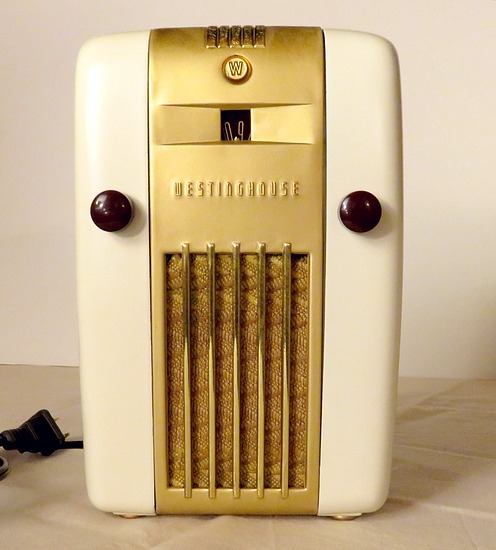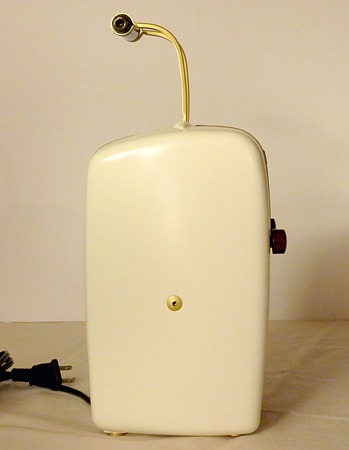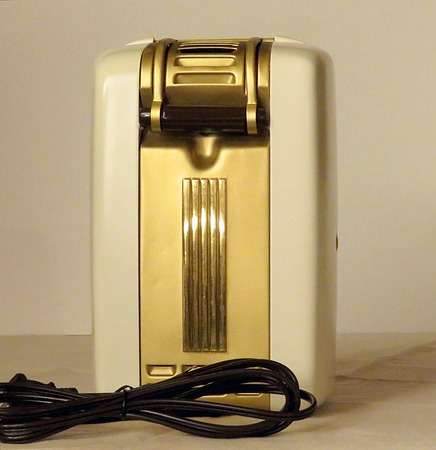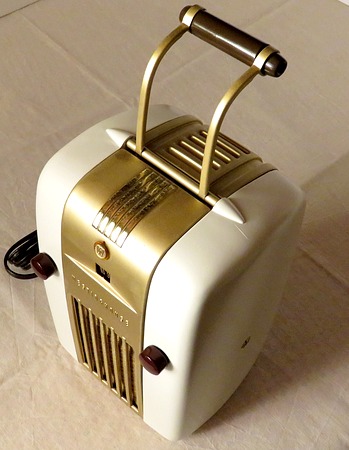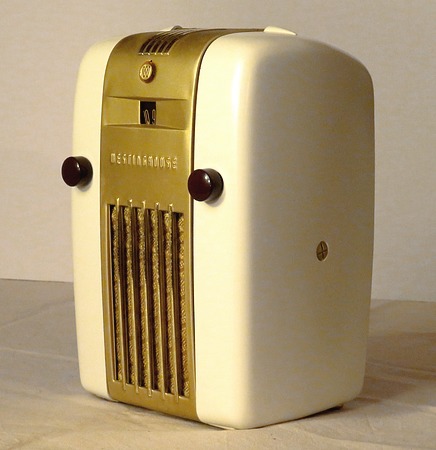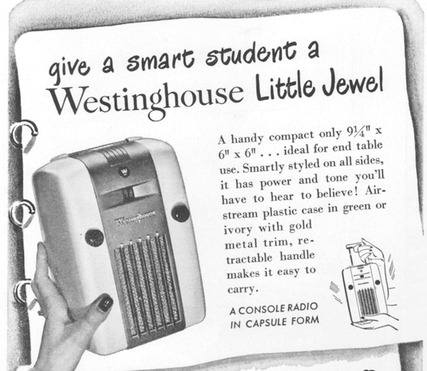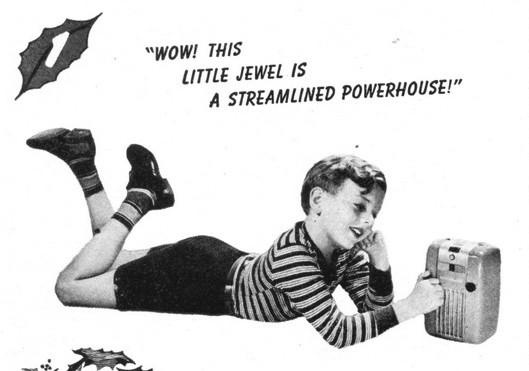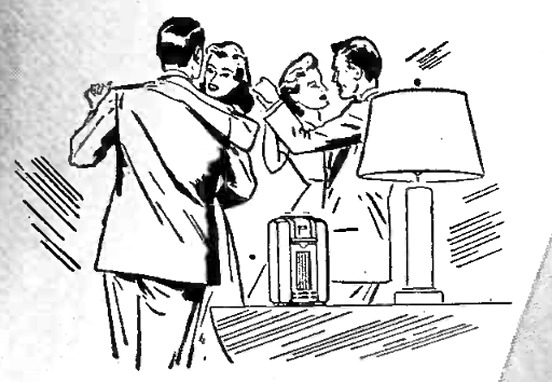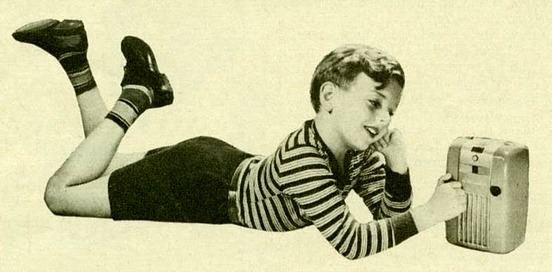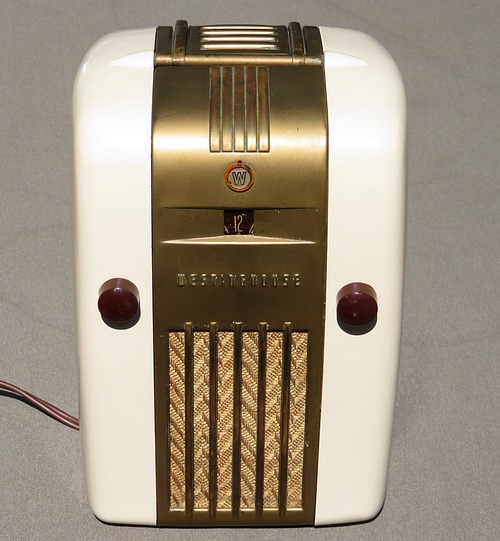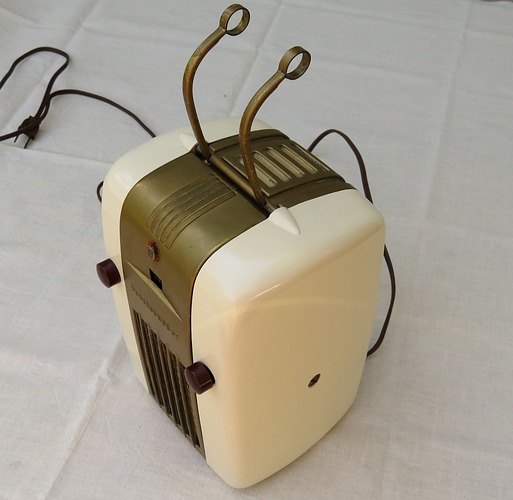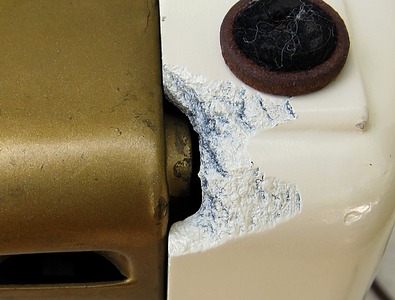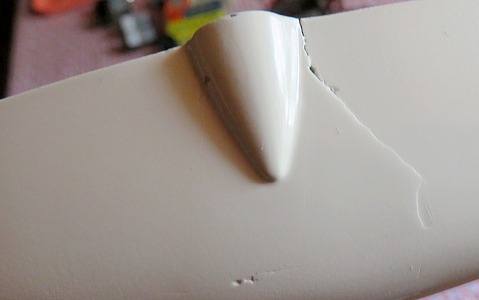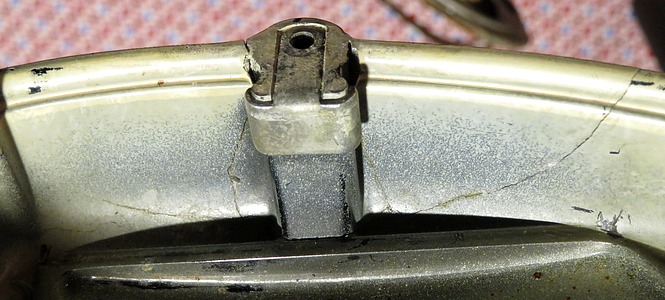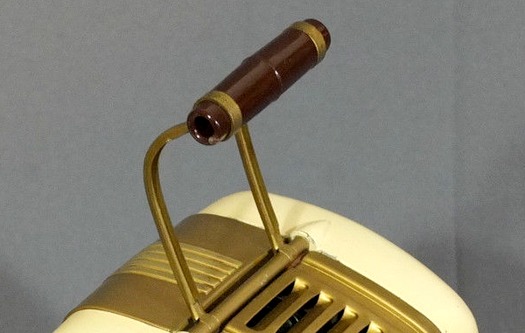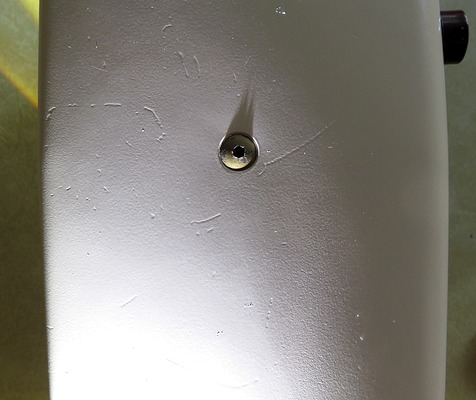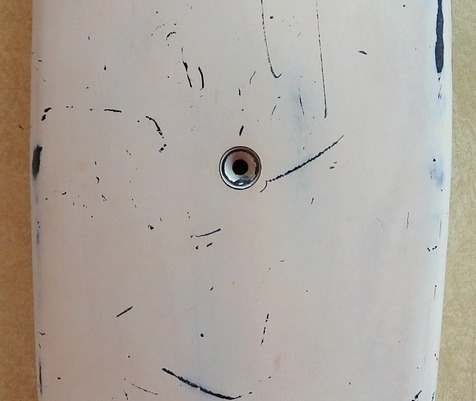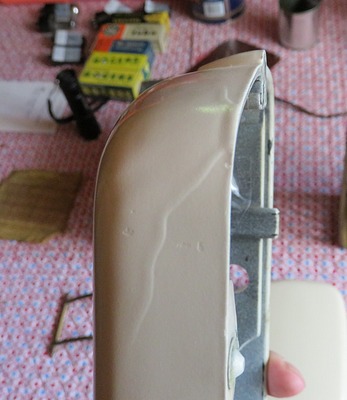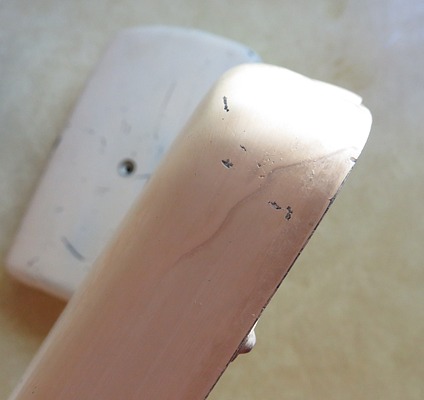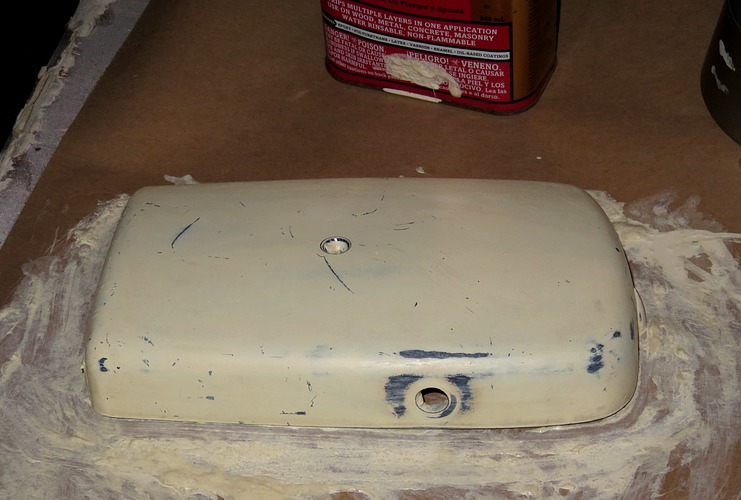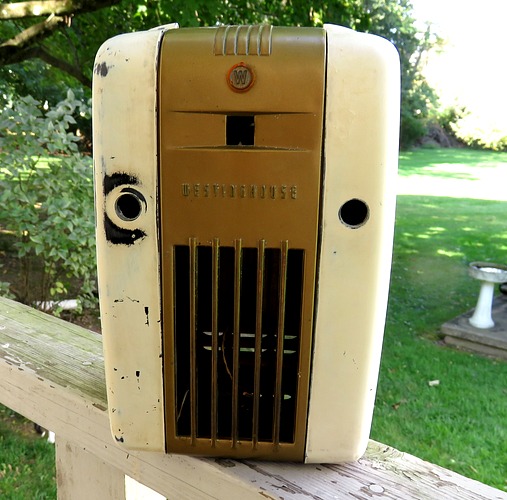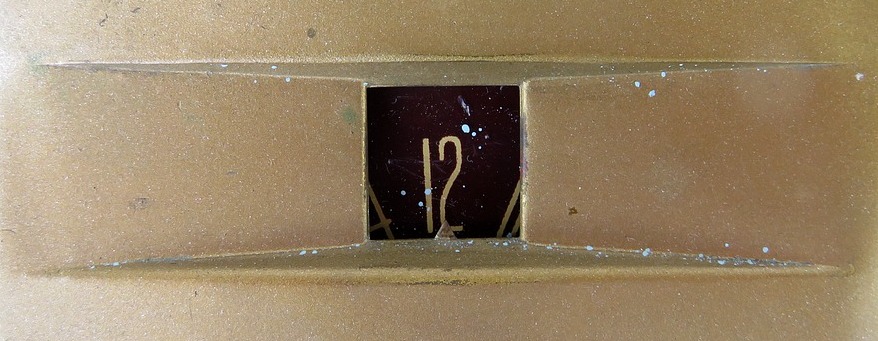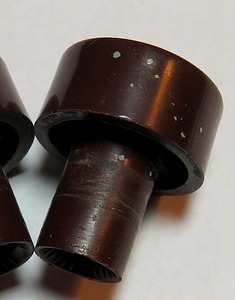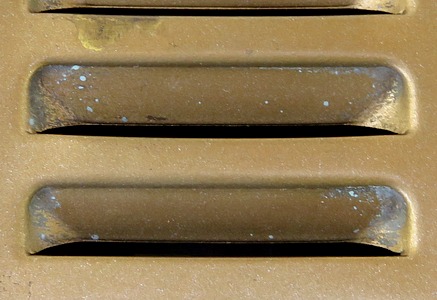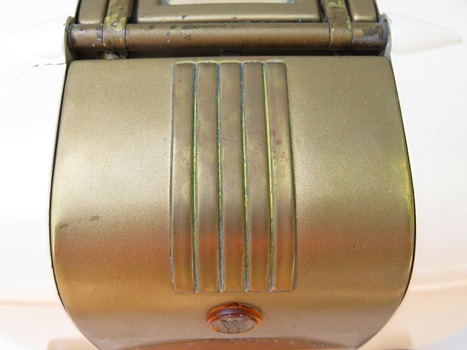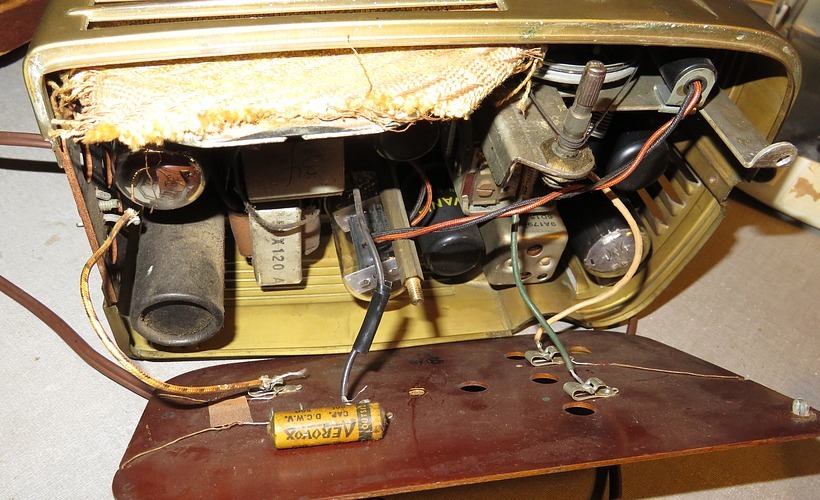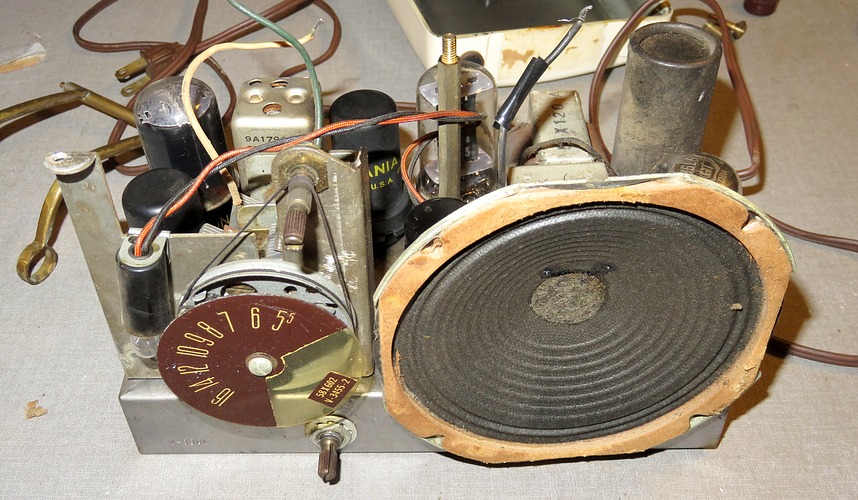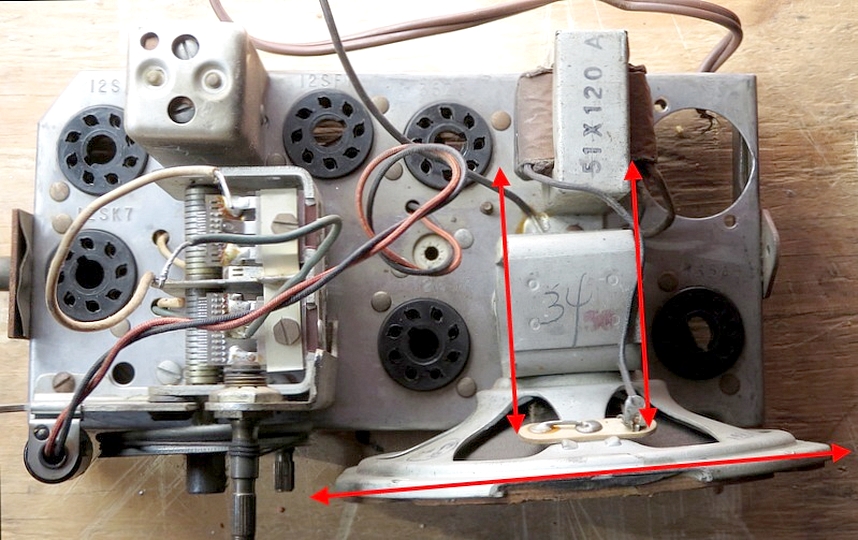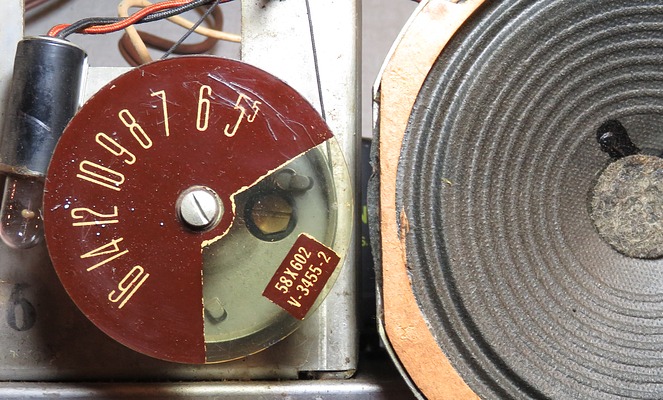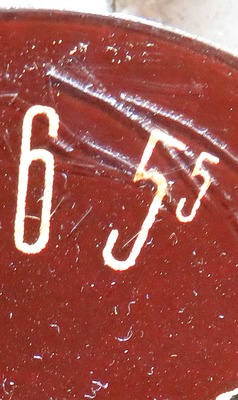 |
Westinghouse
model H-126
"Little Jewel" |
 |
|
|
|
|
|
|
A Westinghouse "Little Jewel."
This one was made sometime between 1946 and 1949. |
|
|
|
|
A six tube superheterodyne AM receiver; there is
a lot of radio packed into a small cabinet. Made in America by
American workers, with parts that were made in America by American
workers. What would those workers think if they knew that in 2017 it
would be repaired with parts that were made in Communist China?
|
|
|
|
|
|
Sometimes called a
"refrigerator radio" because of its styling, there is a story that
in 1945 Westinghouse gave you one for free if you bought a
Westinghouse
refrigerator. This account is repeated over and over on the
Internet but I can't find any of evidence that it's true.
So before we go on, let me state this: (In my opinion) no, you did not get a "Little Jewel" for
free with a
Westinghouse refrigerator, and Westinghouse never referred
to it as a "refrigerator radio."
This is a six tube radio. The outer case is made of over 24
different parts (not including the grille cloth and knobs) and there
are almost 50 components that make up the circuitry. There
is a lot of labor involved just assembling the chassis into
the case. Who
would give one of these away for free when you could give
away a cheap plastic "All American Five" radio instead?
The nail in the coffin - home
refrigerator production ceased during World War II. After
years of austerity measures, food shortages, rationing and
scarcity of every imaginable consumable good, a "free radio"
wasn't needed as bait to get a customer
to buy a new refrigerator in 1945.
The origin of the myth is explained on Page 5. There
actually was a "refrigerator radio" you got for free, but it
wasn't a Westinghouse, it was a Philco. In addition, the
Philco "refrigerator radios" were manufactured prior to the beginning of WWII, not in 1945 after
the war had ended. As the
decades went by, the "free radio with a refrigerator" story became
intertwined with the Westinghouse H-126. |
|
|
|
|
|
|
"Oh my gosh, Bill. That radio looks like a
little refrigerator! It's... it's a refrigerator-radio!!" |
|
|
If I had gone outside
dressed like this, the other kids would have beaten me up. |
|
|
|
|
|
Here's how the radio looked at the
beginning of September, 2017. It looks pretty good
in the picture.
Actually, there are several cosmetic and electrical issues
with this radio. I had "fixed" it in
1987, spray painted the sides and put it in a box. The next
time I looked at it, 30 years had passed.
I remember I thought this was the dumbest looking radio I
had ever seen. Either I or my brother Chris had found it in
the trash. It was in such bad shape I was tempted to put it back
in the trash. Instead, I brought it back to life, painted
the sides and stuck it in a box.
Too bad I didn't have more experience with radios. This
radio has six tubes and
is actually a very fine radio receiver. I didn't know what
the extra vacuum tube did, but something told me to
hold onto the ugly thing. |
|
|
|
|
| So
what's wrong with the radio? It doesn't work
very well. Nor does it have a handle. We can make it work
better, but the only way to get a replacement handle is to
buy another radio and steal the handle. While searching the
Internet and sending out emails looking for a handle, I
found
that these are very collectible and a junker on
ebay
goes for over $100. No, I'm not going to
spend $100 to get a handle. |
|
|
|
|
|
There is a chunk missing from the bottom and the top has a
crack where the handle inserts into the Bakelite case.
(It may not be Bakelite, it might actually be an early type
of plastic.) |
|
| |
|
|
Guess
what. The "crack" is actually a repair of the case,
which had
been broken into several pieces. What kind of glue is
holding it all together? This is an accident
waiting to happen. Again.
By putting a handle on the radio, Westinghouse encouraged
people to carry it from room to room. This also
encouraged people to drop it.
Would the case break
where the handle is attached by picking the radio up by the handle? It's
possible; the radio weighs almost six pounds. What if someone
was swinging the radio by the handle or walked away with it while it was
plugged in?
I can imagine the case
breaking, the radio crashing to the floor (taking a chunk
out of the bottom) and the owner being left with a handle in
his hand that was no longer attached to anything.
Why would you carry it into another room? It isn't
all that portable, you have to plug it in. It was because after World
War II, radios became so affordable you could buy your own
radio and partake in something the radio manufacturing industry called "individualized
listening." In other words, you no longer had to listen
to what everyone else was
listening to on the only other radio in the house. |
|
|
This is what the handle would look like if
it had one. There is really no way for it to fall out of the
metal
brackets, so it must have been broken. I would like to
have seen what actually happened to this radio. |
|
|
|
|
|
| If
you hold a flashlight obliquely to the side you see
blemishes in the new paint that, by sheer coincidence,
correspond exactly to scratches in the old paint. What are
the odds that it would be dinged in the exact same place
TWICE? |
|
|
|
|
|
There
was a sag in the 1987 paint but it turns out it was complements
of Westinghouse. It became more visible (visible-er) by adding
another coat of paint.
|
|
|
|
|
Removing the 1987 spray paint with paint remover. It melted
instantly. The paint remover didn't touch the 1946 paint. I
used three coats of paint remover, two different brands. I
may as well have used water. |
|
|
|
|
Here's the radio case, sort of as it appeared when I found it 30
years ago, because the spray paint came off with the paint
remover. It looks like a robot head
with a black eye. The shell on the right side had twice as
much paint on it, that's why it's not so scratched up. That
is the side that had the sag in the paint.
Looking at the "black eye," fingernail length might not have been
of paramount importance after WWII but there was probably lead in that paint which ended up
in somebody's ham sandwich. |
|
|
|
|
|
|
|
|
|
|
|
|
| There
are tiny blue-green spots all over the radio. I
thought it was mold, but it's paint. Somebody painted the
room the radio was in, and the radio got splattered. It's
oil paint; it won't scrape off with your thumbnail. |
|
|
|
|
| There
are some decorative features on the case that are supposed
to be shiny, but actually look worse than the painted part.
The medallion lights up, but has a chip out of it that allows an
annoying dot of bright light to shine through. |
|
|
To change the tubes, you take off the side and remove
the antenna. The wires are connected with small No. 15 Fahnestock
clips.
All the tubes tested good but there was a 12SK7 in the 12SJ7
socket. |
|
|
|
The radio chassis out of the case. There doesn't seem
to be any damage from the radio being dropped. |
|
|
But wait! While I was
working on it I noticed the speaker was crooked and I
couldn't straighten it. Did this happen when the radio was
dropped?
I wrote to the Antique Radio Forum asking for someone who
has a Little Jewel to take a look for me. Right away a guy
named Tom Albrecht sent a picture showing that it is supposed to
be at an angle. Whew! |
|
|
|
|
|
|
|
Gouges in the plastic dial. How did this happen? The window
for the dial is smaller than a dime, yet somehow something
sharp managed to get in there and scratch it up. No
complaints about the speaker; it is in excellent condition. |
|
|
| |
|
|
| |
